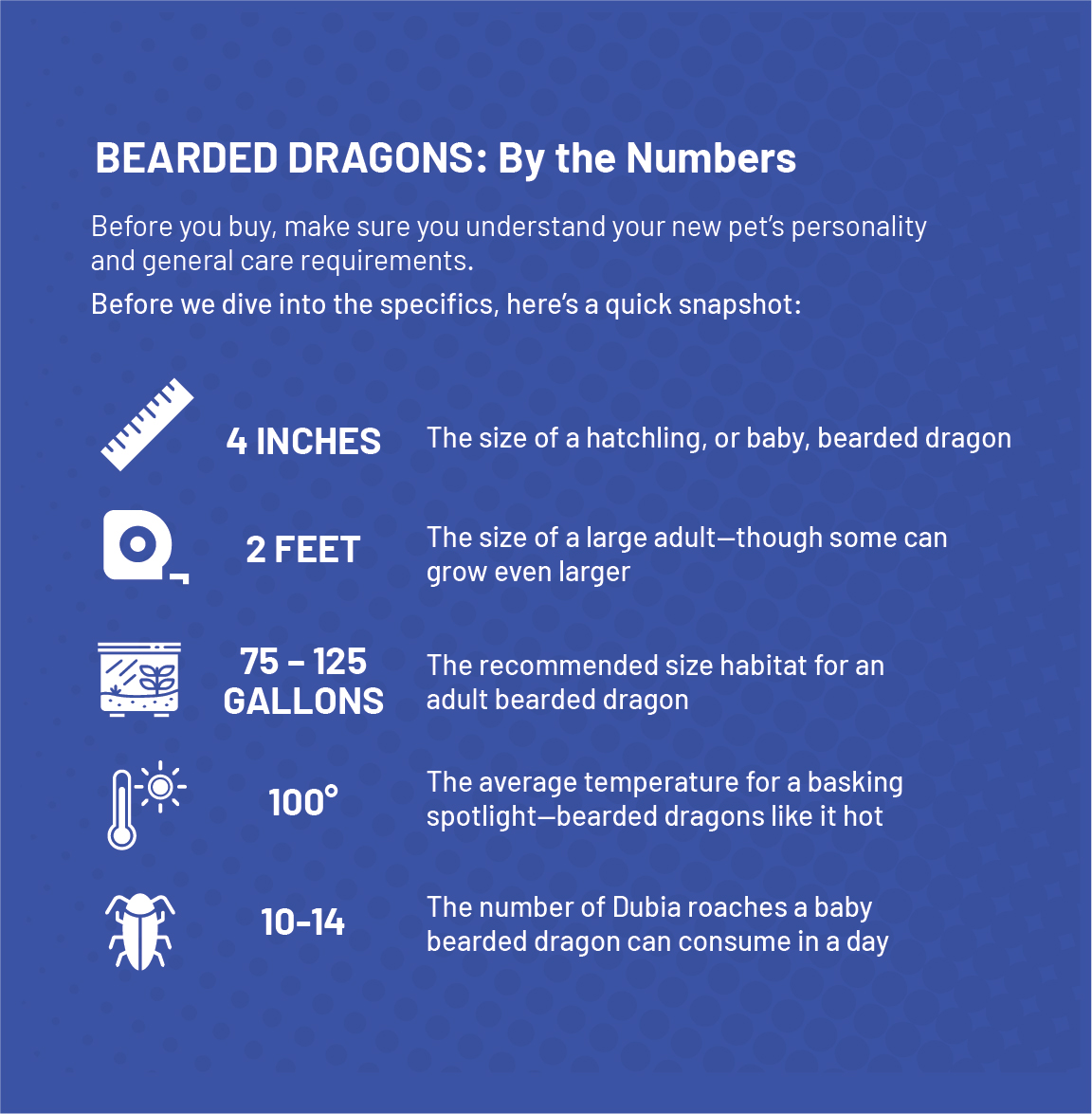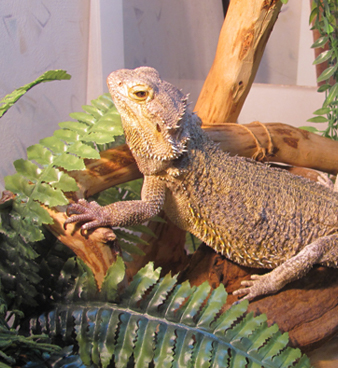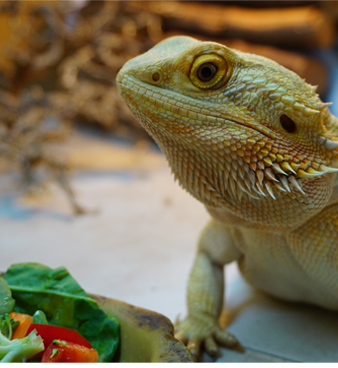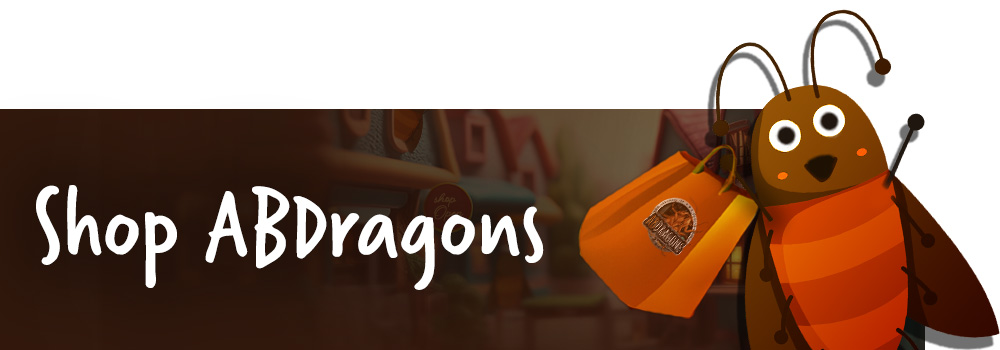How to Care for a Bearded Dragon
Posted by ABDragons on 18th Oct 2019

Bearded Dragon Care 101
Are you deciding whether to buy a bearded dragon? Bearded dragons, generally very docile creatures, make excellent pets. However, your bearded dragon will have a unique personality specific to its breed—and equally unique care needs. It is extremely important to do your research before you buy to ensure you have a thorough understanding of your new bearded dragon’s care needs.

What’s in a Habitat?
Preparing Your Bearded Dragon for a Happy Homecoming
Bearded dragons, just like most pets, will experience anxiety and stress when moving to a new environment. The best way you can minimize your bearded dragon’s stress is to have everything ready to go before you bring him home—this includes an enclosure, proper lighting, heat sources, substrate (or flooring for the enclosure), plenty of food, a water bowl and mister, and any enclosure decorations, such as plants or branches.
The most important place to start is your bearded dragon’s habitat. Keep in mind that the enclosure is among the most expensive items your dragon will need—and it’s not a good idea to “skimp” on quality and size to save money. Here are a few tips:

• The length of your bearded dragon’s enclosure should be 3 times the length of the dragon. A baby dragon will quickly outgrow a smaller enclosure, so many pet owners choose to start with a large 75- to 125-gallon terrarium. You can use a divider to make the space smaller and less overwhelming for a baby dragon until he reaches his adult size.
• Avoid acrylic, which is easily scratched—your dragon will scratch at the glass and, over time, the glass will become clouded and need replaced.
• Never use a glass-top; instead, install a high-quality screen. A glass-top will keep the important UVA and UVB rays from the cage lighting from reaching your bearded dragon.
• Choose your enclosure’s substrate with care. Consider using newspaper, paper towels or reptile carpet. Avoid sand as it can be deadly to bearded dragons when digested. Because the dragon cannot digest the sand, it becomes impacted, causing a blockage in the dragon’s digestive tract that cannot be treated.
• Lighting is key! Make sure you have all necessary lights and heat sources in place, as detailed in the next section.
Let’s Talk About Light
Replicating Your Bearded Dragon’s Natural Habitat
Did you know bearded dragons are native to the hot, desert climate of Australia? Whether you live in warm southern Florida or cool northern Oregon, you will need to replicate the heat and light that your bearded dragon would receive in the wild. Your bearded dragon’s enclosure will be divided into two different temperature “zones,” allowing him to move between them as he pleases. One end of the enclosure will contain a spotlight where your dragon can bask in the sun. This end of the cage may be as hot as 100 degrees. The other end of the cage, away from the basking light, will be slightly cooler.
When choosing lighting, UVB (ultraviolet B) bulbs are a must for bearded dragons. Stay between 5 UVB to 10 UVB when choosing your bulbs. Along with this, there are two key aspects of lighting to remember:
1. Full-Spectrum Lighting: Many bearded dragon owners use fluorescent tube bulbs and mercury vapor light bulbs—which also provide heat—to provide 10-12 hours of lighting each day. The tube bulbs should be approximately 80% of the length of the entire enclosure.
2. Basking Light: There are specific types of heat lamps and bulbs that can be used to provide a warm basking spot for your bearded dragon. Just remember to never use a heated rock as part of your dragon’s basking spot—it will become very hot and can burn their skin.
You will also need to invest in a quality thermometer to help you constantly monitor and control the temperature in the enclosure. Depending on your bearded dragon’s age and the time of day, the lighting and heat inside the enclosure will need to be adjusted.
Fresh Water, Insects, Veggies, and Fruits, Oh My!
Planning Your Bearded Lizard’s Diet

Your bearded dragon will need fresh food and water two times a day at minimum. Some adult bearded dragons require feedings up to 4 or 5 times a day. Bearded dragons are omnivores, meaning they eat both animal and plant matter. To make sure your bearded dragon receives the nutrients he needs, you will also dust his foods with a vitamin and mineral supplement. Young bearded dragons eat 80% animal matter and 20% plant matter. This flips when the bearded dragons become adults.
A bearded dragon’s diet can be divided into four groups:
• Fresh, dechlorinated water (either tap or bottled spring water will work)
• Insects (roaches, black solder flies, mealworms, and hornworms)
• Vegetables (a large variety of leafy greens and finely chopped vegetables)
• Fruits (staple fruits include papaya, mango, and prickly pears)
As you research your bearded dragon’s diet, you’ll find that there are certain varieties of insects, vegetables and fruits that should be staples in its diet and others that should be fed only once or twice a week or as an occasional treat. Avoid spinach, beet greens, lettuce and tomato, which are difficult to digest, and never feed your dragon avocados or rhubarb.
Always keep a shallow bowl of fresh water in your dragon’s enclosure, even if he doesn’t drink it. You will also mist him with water for several minutes, two or three times a day.
Rub a Dub, a Dragon in the Tub
Bathing Your Bearded Dragon
Bearded dragons will need to be bathed at least once per week. A sink works well for a baby dragon, and a tub filled with 1.25 inches of water is ideal for an adult. It is important that your bearded dragon spends 15-20 minutes soaking in warm water. He will take care of the bathing part on his own!
Count on ABDragons to Help You Care for Your Bearded Dragon
When your bearded dragon is counting on you to provide roaches and other insects for his daily meals, you can count on ABDragons. We strive to provide our clients with the highest quality insects possible, helping you keep your bearded dragon healthy and happy.
As you’ve learned from this guide, there are many different things to consider as you plan for your bearded dragon’s care, from selecting different types of insects for feeding to tracking your dragon’s enclosure temperature. If you ever have a question about your bearded dragon’s feeding or care, we’d be happy to speak to you and address your concerns. Remember that the team at ABDragons is always here for you!
Sources:
https://www.beardeddragoncare101.com/bearded-dragon-care-sheet
https://www.beardeddragoncare101.com/what-to-do-before-buying-a-bearded-dragon/
https://www.reptilesmagazine.com/Care-Sheets/Lizards/Bearded-Dragon/


